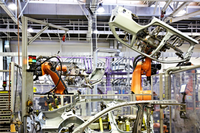Topic of the month May 2014: For investors it pays to take a look under the bonnet

Innovation: for investors it pays to take a look under the bonnet
Global car manufacturers like to reel in the public with elegantly styled bodywork or spectacular visions of the future. However, all the ongoing innovations such as the development of ever-smaller drive units and the increasing electrification of vehicles attract far fewer headlines – even though they are much more pertinent for the automotive industry. For investors, too, it is worthwhile taking a closer look under the bonnet.
The visitors flocking to the Detroit Motor Show and the success of the big car makers bring to our attention that cars – and not dogs – are a man’s (and increasingly woman’s) best friend. The latest models continue to prioritise multimedia connectivity and driving enjoyment, albeit environmental protection considerations are also becoming increasingly important. In other words, modern consumers want to burn less fuel, without sacrificing performance or comfort.
Environmental protection is on the list of priorities, not least because of new regulations. The European Union (EU), for example, has introduced fines for any car maker whose fleet CO2 emissions exceed defined limits – limits that in reality are regularly breached . China and many other emerging countries, whose megacities are regularly shrouded in smog, tend to follow the EU standards after a certain time lag. The USA has also introduced its own standards.
Smaller engines and lighter materials
To meet these stricter emission standards, manufacturers are turning to specialist suppliers with full command of the technologies involved. Intensive research is underway into traditional drive technologies and hybrid engines (for example, combining an internal combustion engine with an electric motor). The trend towards downsizing – in this case shrinking the engine while maintaining the original performance – is hardly surprising. After all, up to two-thirds of the car’s energy input at the pump is lost in the engine from friction, heat and noise. A modern drive unit can produce the same performance with four cylinders that was previously achieved with six.
Other innovations in connection with emission reductions include the increased electrification of vehicles. This is partly being done in the form of hybridisation, namely, the conversion of braking power into electrical power, which is then used for acceleration. It also encompasses replacing various hydraulic oil pumps with small electrical motors, such as for power steering. Furthermore, refinement of battery technology is playing an ever-increasing role in this regard.
Reducing the weight of vehicles by making greater use of carbon fiber is boosting energy efficiency. Ultra-light bodywork, as pioneered by the McLaren racing team in the 1980s, is becoming increasingly prevalent on the mass market, as can be seen by the initiatives taken by companies such as Volkswagen, BMW and Toyota.
Are electric cars on the brink of a breakthrough?
The first series-produced electric vehicles from Tesla and BMW also created waves. There is considerable market potential for such vehicles in Europe, where 80 percent of car journeys are less than 25 km long. The cost of implementing the necessary charging infrastructure is overestimated, given that the electricity grid is already in place and that more and more shopping malls and electricity suppliers are seeking to attract customers by offering free recharging points. Having said that, there is still a lot to do before a blanket network of “charging” docks in homes and cities and at major transport hubs are in place.
The penetration of electric vehicles will largely depend, alongside consumer appetite, on the legal environment. Measures to promote electric cars range from direct subsidies on purchases in the USA to cost exemptions for electric vehicles in certain areas of London and the right to use bus and taxi lanes.
Focus on specialist technology firms
The car industry’s hunger for technological innovation is benefiting suppliers such as BorgWarner (turbo chargers and drive technology) and Maxwell (new forms of battery-charging technology), which in our view are well-positioned to capitalise on the long-term trends. For our clean-technology-focused fund, we are of course also interested in other attractive sectors. The booming world population and trend towards urbanisation are increasing the demand for suitable infrastructure and new technologies. Ever-stricter water quality, energy-efficiency and emissions standards are being introduced here, and this will tend to play into the hands of suppliers working in the fields of water saving and treatment, solar and wind power, efficient transport and energy-saving building technology. In concrete terms, this means that we invest globally in a variety of specialist industrial and service companies focused on clean technology.
 | Author: Pascal Dudle Portfolio manager Vontobel Fund – Clean Technology Vontobel Asset Management |
Additional information can be found on the website www.vontobel.com or on the Vontobel Fundnet fundnet.vontobel.com. All sustainable Vontobel Funds are also listed on www.yoursri.com and ESG and Carbon Fund Screenings als well as Sustainable Fund Assessments are available for those products.


